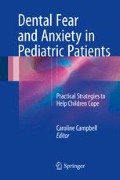Abstract
Communication has both verbal (35 %) and non-verbal (65 %) elements. Non-verbal communications or cues are more readily believed than those of the spoken word. It is the case, for people in general, that “actions speak louder than words” [1]. However, the benefits of understanding both non-verbal and verbal cues are essential in understanding and communicating with your child and adolescent patients. Non-verbal communication is taught well in the dental undergraduate curriculum and so this chapter aims to include information which complements this knowledge.
Access this chapter
Tax calculation will be finalised at checkout
Purchases are for personal use only
References
Freeman R. Communicating effectively: some practical suggestions. Br Dent J. 1999;187(5):240–4.
Freeman R. The psychology of dental patient care: the common-sense approach. Br Dent J. 1999;186:450–2.
Kipping P, Gard A, Gilman L, Gorman J. Speech and language development chart. 3rd ed. Austin: PRO-ED; 2012. p. NA.
Piaget J, Inhelder B. The psychology of the child. New York: Basic Books; 1969.
Eiser C, Kopel S. Perceptions of health & illness New York: Routledge; 2013.
Koller D, Khan N, Barrett S. Pediatric perspectives on diabetes self-care: a process of achieving acceptance. Qual Health Res. 2015;25:264–75.
Gilchrist F, Marshman Z, Deery C, Rodd HD. The impact of dental caries on children and young people: what they have to say? Int J Paediatr Dent. 2015;25:327–38.
Smith L, Callery P. Children’s accounts of their preoperative information needs. J Clin Nurs. 2005;14:230–8.
Rodd HD, Hall M, Deery C, et al. Video diaries to capture children’s participation in the dental GA pathway. Eur Arch Paediatr Dent. 2013;14:325–30.
NIHR Medicines for Children Research Network (MCRN) Young Person’s Advisory Group. Unknown. Guidance document for researchers designing patient information leaflets. NIHR Medicines for Children Research Network (MCRN) Young Person’s Advisory Group. Available: https://www.crn.nihr.ac.uk/wpcontent/uploads/crnadmin/Children-patientinformation-guidance.pdf. Accessed 31 May 2016.
Liossi C, Noble G, Franck LS. How parents make sense of their young children’s expressions of everyday pain: a qualitative analysis. Eur J Pain. 2012;16(8):1166–75.
Stanford EA, Chambers CT, Craig KD. A normative analysis of the development of pain-related vocabulary in children. Pain. 2005;114:278–84.
Franck L, Noble G, Liossi C. Translating the tears: parents’ use of behavioural cues to detect pain in normally developing young children with everyday minor illnesses or injuries. Child Care Health Dev. 2010;36:895–904.
Ross DM, Ross SA. Childhood pain: the school-aged child’s viewpoint. Pain. 1984;20:179–91.
Toole RJ, Lindsay SJ, Johnstone S, Smith P. An investigation of language used by children to describe discomfort during dental pulp-testing. Int J Paediatr Dent. 2000;10:221–8.
O’Connor J. The NLP workbook: the practical guide to achieving the results you want. ISBN – 13 978–0–00-710003-3, 2001.
Sturt J, Ali S, Robertson W, Metcalfe GA, Bourne C, Bridle C. Neurolinguistic programming: a systematic review of the effects on health outcomes. Br J Gen Pract. 2012:e757–64. doi:10.3399/bjgp12X658287.
The NLP Comprehensive distance learning practitioner integration and certification program C Faulkner; 2009.
NLP – the living encyclopedia of NLP – volume 1. Building bridges to the future. 2004–2007.
Shapiro M. Understanding neuro-linguistic programming in a week. ISBN 0 340 71123 X, 1998.
Lang E, Laser E. Patient sedation without medication – rapid rapport and quick hypnotic techniques. Printed in Great Britain by Amazon.co.uk, Ltd. Marston Gate, 2009.
Howard KE, Freeman R. Reliability and validity of a faces version of the modified child dental anxiety scale. Int J Paediatr Dent. 2007;17:281–8.
Author information
Authors and Affiliations
Corresponding author
Editor information
Editors and Affiliations
Rights and permissions
Copyright information
© 2017 Springer International Publishing AG
About this chapter
Cite this chapter
Gilchrist, F., Campbell, C. (2017). Communication and the Use of Language. In: Campbell, C. (eds) Dental Fear and Anxiety in Pediatric Patients. Springer, Cham. https://doi.org/10.1007/978-3-319-48729-8_8
Download citation
DOI: https://doi.org/10.1007/978-3-319-48729-8_8
Published:
Publisher Name: Springer, Cham
Print ISBN: 978-3-319-48727-4
Online ISBN: 978-3-319-48729-8
eBook Packages: MedicineMedicine (R0)

